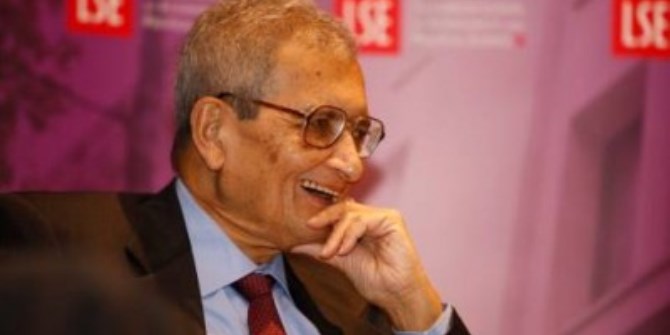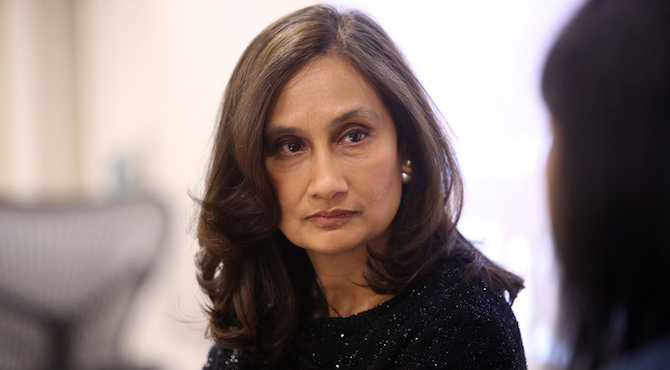 Economic history is a frequently overlooked branch of both history and economics. Amal Shahid recently spoke to LSE’s Tirthankar Roy about the value of studying the discipline in relation to South Asia, why it has been sidelined and what the UK and India can learn from each other about teaching it.
Economic history is a frequently overlooked branch of both history and economics. Amal Shahid recently spoke to LSE’s Tirthankar Roy about the value of studying the discipline in relation to South Asia, why it has been sidelined and what the UK and India can learn from each other about teaching it.
You have worked extensively on industrial growth and factor markets in colonial India, how would you say this informs our understanding of contemporary India?
Let me start with a statistical parallel. If we divide Indian GDP into three segments – agriculture, government, and private enterprise outside agriculture (industry, trade, transport, and financial services, mainly) – we observe that between 1900 and 1947 there was impressive growth in private enterprise, and inertia in agricultural income and the government. After the economic liberalisation of the 1990s, that is, between 1990 and 2016, there was again much faster growth in non-agricultural private enterprise than in agriculture and the government. In the middle decades of 1950-1990, when India followed a deeply protectionist and insular policy, private enterprise moved relatively slowly.
What was similar between the colonial times and the post-reform years? The answer is openness. The parallel tells us that openness to trade and investment is good for capitalism, whether we consider the colonial times or the postcolonial. The open economy did not deliver capitalistic growth in the same fashion in both eras. But there were similarities. In both the periods, not only commodities but also capital and labour were mobile, which encouraged freer flow of knowledge, skills, and technology, and created incentives for domestic producers to become better at what they were doing.
To put the point differently, the recent economic resurgence of the Indian economy is linked to some historically inherited strengths, such as, an experience of industrialisation that dates back to the nineteenth century, a well-developed financial system, and perhaps most importantly, a cosmopolitan business culture. The region had been in the past a major manufacturing centre and a very open marketplace that attracted traders from all over the world. The state-led development policy of the post-war era modified the legacy, but also built on its strengths. For example, many of the business groups that benefited from Nehruvian socialist industrialisation of the 1950s through the 1970s had emerged into prominence in the colonial-era trade.
It is necessary to stress the lesson that open markets and cosmopolitanism were good for the Indian economy, because the political rhetoric in India remains trapped in nationalism, which tends to blame global trade and global capital for poverty and underdevelopment. That sentiment started as a criticism of the British Raj, nurtured by the left, and the negativity persists. The pessimistic view of openness is based on a misreading of economic history. There were many things seriously wrong with the British Raj, but market-integration was not one of these. Influenced by a wrong reading of history, India’s politics remains unnecessarily suspicious of globalisation and cosmopolitanism.
Your recent work has been focused more on business history, do you think that this area is relatively unexplored in Indian economic history?
Since writing The East India Company (Penguin India, 2012), I developed an interest in business history. Entrepreneurs and firms frequently move between cultures, shape politics and policy, and are good subjects for students of globalisation. And yet, business history and economic history rarely interact. In India, the separation has been bad for both fields, and has left business history a marginal field. Economic history neglects personalities, while business history tends to be preoccupied with personalities.

The revival of private enterprise in the region since the 1990s made many people curious about business history. In 2013, I was invited to teach the subject in the Indian Institute of Management (IIM) Ahmedabad. The invitation and my own wish to integrate economic with business history led me to develop several projects. One of them is a book now in the making, which places the experiences of firms, entrepreneurs, and groups against the business environment, in the process engaging often with interpretations of economic history.
Are there other themes that are under-researched in South Asian economic history?
Environmental history is another example of an under-researched field. Environmental economics is a big subject in South Asia, especially in India, but it is mainly populated by scientists, technologists, economists, not historians. What is known as environmental history in India consists mainly of studies on British colonial policy. It tells you more about politics than about the natural world and how it changed, and interacted with material life and livelihoods. Politics of course matters to the story, but so do population, technology, climatic change and a host of other things not directly linked with politics.
Would you agree with the statement that economic history has been taken over by social and subaltern history?
Social history and economic history have always had a close bond. To develop a deep understanding of a particular context, it is necessary to have knowledge of both social organisation and economic conditions. More recently, the two grew apart, and not just because of over-specialisation. The rise of quantitative and analytical history turned some economic historians closer to economics. Within social and cultural studies, there was a deliberate distancing from economic history (see my comment below).
Subaltern Studies is an intellectual movement that started with a reinterpretation of Indian nationalism, which emphasised the role of non-elite politics in anti-colonial struggle. Although concerned with certain livelihood groups, like agricultural workers and forest-dependent peoples, this movement side-lined economic history, at first because it was focused on politics, and later under the influence of cultural history. However, the best days of the movement are over.
Do you think the detachment of social and economic history over time is problematic?
In the 1980s when we were doctoral students, the history departments in India used to teach a lot of economic history. That interest in economics from historians gradually died down, for a number of reasons. The major reason was the influence of postmodernism, which turned the whole field towards cultural history and away from economics. Postmodern historians did not like economic history because they thought that there was a hidden modernising and Eurocentric message behind the preoccupation with economic growth. A slow turnaround has now begun. Economic history is creeping back in history schools. But in South Asia the trend is still weak.
Over the past few years, neither historians nor economists have been willing to venture into this field in India. What would you say are the reasons for this?
For someone contemplating doctoral research, one of the motivations to choose a specialisation is job prospects, and there are not many economic history jobs. But again this is changing for the better. There are more teaching and postdoctoral positions in economic history worldwide.
Sadly, the trend is almost invisible in the Indian academia. Economic history jobs dried up in the 1990s and there is no immediate sign of a revival. It is a very small specialisation whether in history or in economics, almost invisible. I have often given public talks in India, but more of these were arranged by corporate executives than by academic economists or historians. The surprising thing is that the teaching curriculum is not as indifferent to economic history as research or the job market is. From the examples I know of, the teaching is typically handled by a non-specialist.
I imagine that the irrelevance of economic history is a bigger problem in Pakistan and Bangladesh. For after all, India has several hundred universities, and who knows where the interest in the subject or the problem of long-run economic growth still inspire classroom discussions.
In your experience, how is economic history in India taught differently than in the UK?
One obvious difference is that in the UK, at least in the courses we offer in the Department in LSE, the focus usually falls on the historical process rather than the regions as such. For example, my course on India during the British imperial era reminds the students that the processes of change were not necessarily unique to India, but that studying India helps us to create a richer idea of the empire itself. In India the same subject will be taught with reference to India’s own distinct trajectory of change. In short, teaching here is more global than regional in spirit, whereas it is the other way round in India.
What do you think they can learn from one another?
From the Indian side, the lesson to be learned is that global history needs to be taught widely. Many emerging nations have this problem, they take their own national histories too seriously. This needs to change, and the lesson to be learned is that there are other ways of doing history and that the nation is not necessarily the best unit of study. National history is especially unsuitable when we deal with such world-changing forces as trade, migration, cross-border investment, and the processes of learning. These are the standard ingredients of a global economic history. Teachers of the field in India are, in fact, sensitive to global history, but a radical revision of courses and programmes takes time because the university system is bureaucratic and state-dominated.
From the UK end, the main lesson to be learned is that global history cannot just be about comparing and connecting world regions, it simultaneously needs to engage with the social and cultural particularities of regions. Some of the contemporary debates in global history, like the ‘great divergence’ debate, have not always paid sufficient attention to the complexity of Indian history or Indian geography, in my view. There is scope for a better collaboration between region experts and global economic historians.
Note: This article gives the views of the author, and not the position of the South Asia @ LSE blog, nor of the London School of Economics. Please read our comments policy before posting.
About the Authors
 Tirthankar Roy is a Professor in LSE’s Department of Economic History.
Tirthankar Roy is a Professor in LSE’s Department of Economic History.
 Amal Shahid is pursuing her Masters degree in Economic History (Research). She has an undergraduate degree in History from Sri Venkateswara College, University of Delhi. Currently, she is researching migration and labour history of colonial and post colonial India.
Amal Shahid is pursuing her Masters degree in Economic History (Research). She has an undergraduate degree in History from Sri Venkateswara College, University of Delhi. Currently, she is researching migration and labour history of colonial and post colonial India.








9 Comments